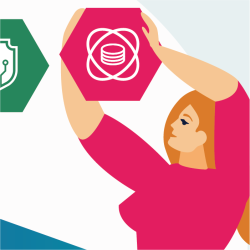Back to School: OIT's Rajiv Uppal Reflects on HALO
In addition to promoting a culture of lifelong learning, CMS OIT Director and CIO Rajiv Uppal models it.
Earlier this month, he took the Better Together: Human-Centered Design + Agile + Lean (HALO) course. HALO is the introductory course for any CMS OIT employee interested in the Workforce Resilience Program (WR).
WR offers CMS OIT employees growth opportunities in different career tracks. Participants have the choice of merely familiarizing themselves with a new content area or diving deep and becoming a subject matter expert. There are currently five WR tracks: human-centered design, product management, cloud, cybersecurity, and data science.
Human-Centered Design (HCD), Agile, and Lean underpin all of the tracks, so HALO serves as the foundation for all WR participants. OIT staff can register for HALO at https://ams.hhs.gov/amsLogin/SimpleLogin.jsp.
After taking HALO himself, Uppal offered perspective on why the course is so critical to the evolution of CMS OIT.
How do the Lean, Agile, and HCD approaches fit together?
Lean, Agile, and HCD are three proven approaches that we intentionally chose to empower our employees to increase efficiency at OIT and to fulfill our mission more effectively.
Lean systems thinking focuses on how we do what we do, reducing waste, and optimizing value. HCD keeps us focused on customer needs so that we create useful, usable products and services. An Agile approach marries our internal processes with a customer-centric design philosophy. Therefore, we can devise solutions through an iterative process that allows for frequent feedback and rapid refinement.
Finally, the methods of the three approaches overlap very neatly. For example, we can easily integrate small improvement sessions (from Lean), rapid prototyping (from HCD), and iterative delivery (from Agile).
How do these three approaches lead to workforce resilience?
WR offers employees the opportunity to learn new skills at their own pace so they can grow in their careers. Lean, Agile, and HCD are frameworks that will allow us to adapt to changing standards, changing customer needs, and changing circumstances. For instance, a global pandemic that forces us to completely transition to a work-from-home model with little notice.
Although the methods we employ to address any one specific professional challenge may be different, our core set of principles will not change. Further, those principles will ensure that we choose the right tools and apply them appropriately. They give us direction, and they help us to make judicious decisions.
If our career is a journey, think of HALO as our compass. We can travel by boat, by car, or by plane, but no matter our means of travel, having that compass will help us reach our destination.
What did you learn from the course?
The great thing about the HALO course is that it offers concrete techniques for leveraging the HCD + Lean + Agile mindset. For example, how do we design a business plan? How do we scale? How do we choose criteria for decision-making? The course content is not just philosophical; it teaches processes that we can take back to our workplaces and implement with our teammates.
How is HALO critical to the success of OIT?
I envision a workforce where each employee feels like they have the freedom to experiment and the necessary expertise to solve problems creatively while sharing a common purpose and an integrated workflow. HALO is a big step in that direction.

